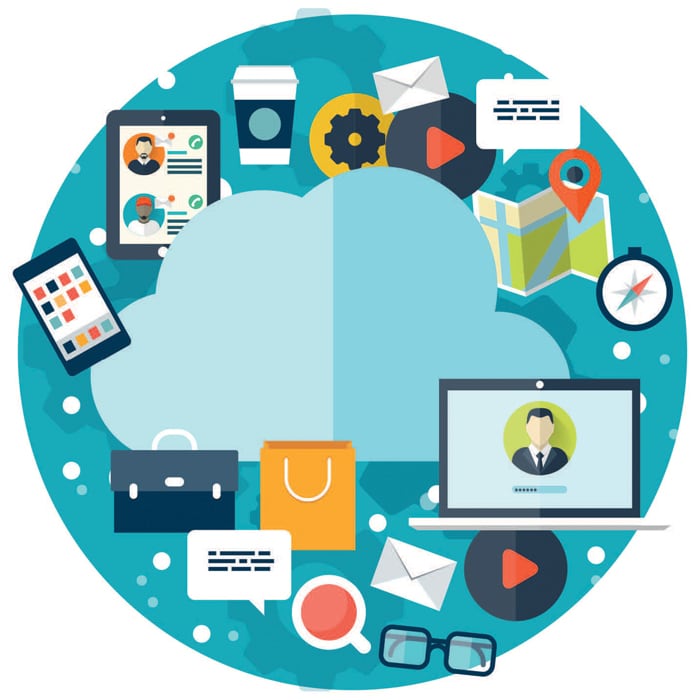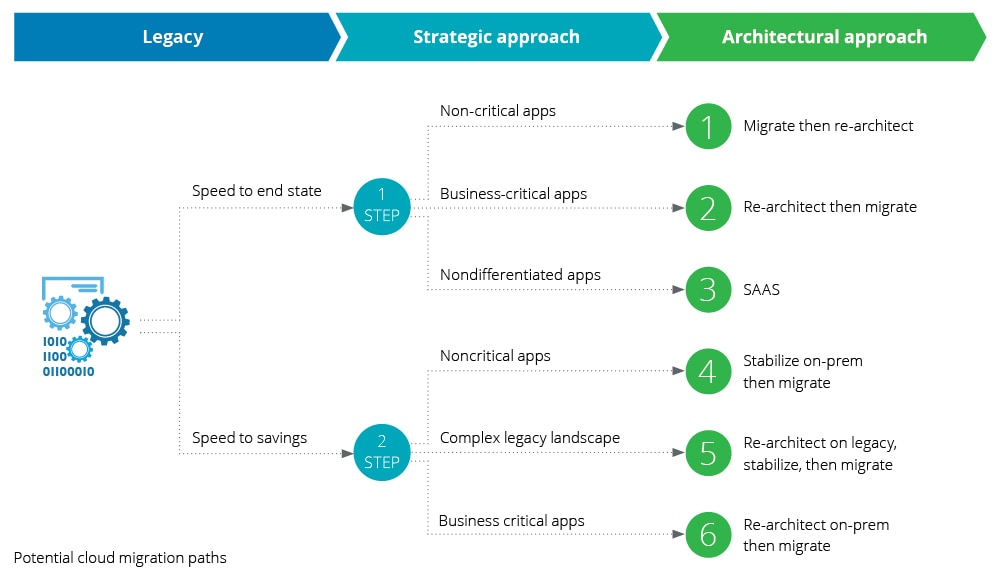Six cloud migration strategies for consumer products and retail has been saved

Perspectives
Six cloud migration strategies for consumer products and retail
Approach app modernization in one or two steps
Consumer products and retail companies have lagged when it comes to cloud migration strategy. But this situation can’t go on much longer. The impending recession, the next recovery, and changing business models are all making the need for a cloud migration strategy more important than ever. Here are six paths you can take.
Explore content
- The need for a cloud migration strategy
- Cloud migration strategy’s crucial role
- Three steps toward determining your cloud migration strategy
- One-step cloud migration strategies
- Two-step cloud migration strategies
The need for a cloud migration strategy
Although cloud migration has been on the agenda of retail and consumer products companies for years, many companies have lagged behind other sectors when it comes to porting their core legacy business applications to the cloud. Despite positive experiences with a variety of customer-facing applications and the benefits of cloud in IT (information technology) cost savings and enhanced agility, few companies have taken this step.
The reasons for the lag are primarily logistical. In the past, companies have commonly patched numerous applications together to meet evolving requirements, devoting the lion’s share of their limited IT budgets to apps that promise competitive differentiation.
But focusing on new apps usually adds more complexity to the landscape, the technical debt continues to accumulate, and overall system performance declines while operational risks rise. All the while, opportunities and competitor challenges go unmet.
Cloud migration strategy’s crucial role
Clearly, this approach can’t go on much longer. And three upcoming challenges are likely to exacerbate the situation:
- The next recession: Many economic observers predict an inevitable recession in the coming year—but the cloud can play a crucial role in streamlining operations and reining in costs, shifting more IT costs from Capex to Opex. IT teams can also avoid purchasing and maintaining assets just to support the peak sales period. Growing the share of variable cost in the IT budget reduces the cyclical risks of mistimed digital investments.
- The next recovery: The inherent scalability of cloud systems means that it’s more difficult for the company to overshoot on its investments during a growth period. At the same time, better analytics improves the company’s ability to forecast not only the next downturn, but also the next upturn, giving executives a clearer idea of how to time their capital investments.
- The next business model: A cloud-based core makes it easier for the company to respond to spikes in demand and also make transformational changes to the business. Once core processes are in the cloud, the IT function moves beyond being a support organization and can finally become a true business partner—while dispensing with seasonal code freeze constraints. With the right IT in place, companies can carry out their work at a holiday level of preparedness every day of the year.

Three steps toward determining your cloud migration strategy
Before a company can move its core processes to the cloud, it needs to take three preliminary steps:
- Classify applications: Differentiating, customer-facing applications that drive business value are prime candidates for investment to modernize. Nondifferentiating, back-end applications should be maintained as is or migrated to the cloud using a low-cost approach. Nonstrategic, legacy applications are often candidates for retirement.
- Identify simplification opportunities: For applications that are being retained, the company should determine which applications have overlapping functionality and can be combined.
- Prioritize applications: Based on the above analyses, the company should set its modernization priorities. These priorities should consider the ease of working with the application architecture and the strategic business value of the application.
With this foundation in place, companies can approach legacy-to-cloud migration in one step (directly from legacy to the cloud) or two steps (moving from legacy to a more modern on-premises platform, and then migrating to the cloud)—six options in all.

One-step cloud migration strategies
Rapidly migrate applications to the cloud without an underlying redesign. Mainframe applications will be rewritten one-to-one in a modern language, such as Java, before migration. Often these revisions can be executed automatically by using such software as Deloitte’s automated innoWake solution. Once applications are in the cloud, the team can further rearchitect and rationalize incrementally, based on the prioritization discussed above.
● Pros: A fast transition off the legacy infrastructure and rapid migration of users to cloud apps.
● Cons: There are inherent risks in moving complex legacy applications to the cloud. Those risks can be partially mitigated by performing extensive testing, but this approach comes at the expense of speed. Consequently, we generally don’t recommend this path for highly complex, business-critical applications.
Based on their prioritization, applications are incrementally rearchitected, tested, and deployed to the cloud. No apps are moved until they have been optimized for cloud.
● Pros: Delaying migration until applications have been made cloud-native ensures proper behavior and performance when they reach the cloud, reducing risk.
● Cons: The slower migration of applications to the cloud means that the legacy infrastructure must be retained for a longer time. Additionally, it may be hard to separate out applications from the legacy architecture, requiring temporary integrations between legacy and cloud applications. Moreover, users may find it undesirable to work with both modern and legacy applications simultaneously.
Nondifferentiating legacy applications can be replaced with a software-as-a-service (SaaS) solution that provides corresponding functionality. The legacy application is then decommissioned.
● Pros: This approach provides a relatively quick way to erase a technical debt and migrate to a cloud-native application. Moreover, because the SaaS provider manages the application, the company’s overhead is usually reduced.
● Cons: Often, change management is needed to ease the transition to new business processes. In addition, the approach entails some loss of control by the company because it’s tied to the SaaS provider’s product roadmap.
Two-step cloud migration strategies
Mainframe applications are rapidly converted to a modern language, such as Java, and transferred to on-premises or private cloud infrastructure. Mainframe infrastructure can then be decommissioned. In the second step, after stabilization of the applications, they’re migrated to public cloud, without significant redesign. Applications are then incrementally redesigned and rationalized based on the prioritization.
● Pros: Rapid cost savings by decommissioning the mainframe, but with less risk than path 1, as stabilizing applications hosted on premise or private cloud infrastructure increases confidence that the applications will perform well on cloud.
● Cons: There is still a risk, albeit reduced, that those applications that haven’t been redesigned may perform suboptimally on the cloud. What’s more, the need to provision temporary hosting makes this path more expensive than a one-step approach.
In the first step, mainframe applications are incrementally rearchitected or rewritten and transferred to on-premises or private cloud infrastructure. Once stabilized, the rearchitected applications are migrated to cloud.
● Pros: This path is the least risky one for mainframe applications, as applications are only decommissioned once they’re fully rearchitected and stabilized.
● Cons: The company may realize savings at a slower pace related to the mainframe infrastructure, because it’s not decommissioned as rapidly.
This path uses the first step of path 4, as mainframe applications are rapidly transferred to on-premises or private cloud infrastructure. Then applications are redesigned on premises and only migrated to the cloud incrementally after redesign.
● Pros: The hybrid approach quickly moves applications off the mainframe, while mitigating the risks that would arise from moving applications to the cloud before they’re made cloud-ready.
● Cons: Because applications are redesigned on premises or on private cloud, the temporary infrastructure must be maintained for a relatively long time.
Optimizing the human network
Digital assets aren’t the only resource strategists should consider before choosing the right path forward. The people who will use, operate, and in some cases redesign these systems must also be fully committed to the cloud journey. In the end, convincing them of the importance of making the journey may be nearly as critical as choosing the right path.
Next, you need to consider who to bring in to help advise you on the appropriate approach, execute the migration, and guide you on the change journey. There are many software vendors and system integrators on the market that can handle pieces of a digital transformation. But relatively few have the capacity to look strategically at a company’s digital challenge, devise a plan for meeting that challenge, and execute the plan.
You need a company that can offer:
- Knowledge and expertise of your industry, with deep insights and a proven track record regarding how digitalization can enhance your competitiveness
- Recognized experience performing change management and leading employee education campaigns integrated into the larger offering
- End-to-end technological support for rolling out the solution, which includes assessments of current conditions, plans for app modernization and migration, and the ability to build highly scalable cloud-native applications

Get in touch
Habeeb Dihu |
Ankit Koradia |
Saachi Sahni |
Ian Chappell |
|

